25.07.2021
NASA Invites Media to Next SpaceX Cargo Launch to Space Station

Media accreditation is now open for SpaceX’s 23rd cargo resupply mission to the International Space Station. Liftoff of the Dragon spacecraft on a Falcon 9 rocket is targeted for late August from Launch Complex 39A at Kennedy Space Center in Florida.
Media prelaunch and launch activities will take place at Kennedy. Credentialing deadlines are as follow:
- International media residing in the United States must apply by Friday, July 30.
- U.S. media must apply by Friday, Aug. 6.
For media with special logistical requests, such as space for satellite trucks, tents, or electrical connections, please email Allison Tankersley at allison.p.tankersley@nasa.gov by Friday, August 13.
NASA has updated its COVID-19 policies to remain consistent with new Centers for Disease Control and Prevention guidance. Credentialed media will receive additional details from the media operations team at NASA’s Kennedy Space Center in Florida.
For questions about accreditation, please email ksc-media-accreditat@mail.nasa.gov.
For other questions, please contact Kennedy’s newsroom at 321-867-2468.
The spacecraft will deliver a variety of NASA science investigations to the station, including a study on preventing and treating bone density loss, an investigation that will test diagnostic devices that could detect and mitigate vision disorders, and a new robotic arm for demonstration that could reveal potential uses on Earth, including in disaster relief. The capsule also will deliver materials including concrete, fiberglass composites, and substances that can offer protection against radiation, to investigate how they respond to the harsh environment of space. Additionally, nanofluidic and educational experiments will utilize the function of a new research facility aboard the orbiting laboratory.
This is the third SpaceX mission to deliver science investigations, supplies, and equipment for NASA under the agency’s second Commercial Resupply Services contract. Cargo resupply by U.S. companies significantly increases NASA's ability to conduct new investigations at the only laboratory in space. Space station research through the ISS National Laboratory also provides opportunities for other U.S. government agencies, private industry, and academic and research institutions to conduct microgravity research that leads to new technologies, medical treatments, and products that improve life on Earth.
Humans have occupied the space station continuously since November 2000. In that time, 243 people and a variety of international and commercial spacecraft have visited the orbiting laboratory. The space station remains the springboard to NASA's next great leap in exploration, including future missions to the Moon and eventually Mars.
Quelle: NASA
----
Update: 23.08.2021
.

Quelle: NASA
+++
NASA Sets Coverage, Invites Public to Virtually Join Next Cargo Launch

NASA commercial cargo provider SpaceX is targeting Saturday, Aug. 28, at 3:37 a.m. EDT to launch its 23rd commercial resupply services mission to the International Space Station. Liftoff will be from Launch Complex 39A at the agency’s Kennedy Space Center in Florida. SpaceX’s Dragon spacecraft will deliver new science investigations, supplies, and equipment for the international crew.
Live coverage will air on NASA Television, the NASA app and the agency’s website, with prelaunch events starting Friday, Aug. 27.
Dragon will deliver a variety of NASA investigations, including one that will determine if metabolites from grape skins and seeds used in wine making could help prevent and treat osteoporosis. A new robotic arm scheduled for demonstration could reveal potential uses on Earth, including in disaster relief. Another experiment will test an implantable, remote-controlled drug delivery system that will utilize a new research facility aboard the orbiting laboratory. Several Girl Scouts’ experiments also will use this new facility to study plants, ants, and brine shrimp in microgravity.
About 12 minutes after launch, Dragon will separate from the Falcon 9 rocket’s second stage and begin a carefully choreographed series of thruster firings to reach the space station. Arrival to the station is planned for Sunday, Aug. 29. Dragon will dock autonomously to the forward-facing port of the station’s Harmony module, with Expedition 65 Flight Engineers Shane Kimbrough and Megan McArthur of NASA monitoring operations.
The spacecraft is expected to spend about a month attached to the orbiting outpost before it returns to Earth with research and return cargo, splashing down off the coast of Florida.
Full coverage of this mission is as follows (all times Eastern):
Friday, Aug. 27
9:30 to 11 a.m. – Previously credentialed media will have an opportunity to speak one-on-one with scientists in their labs and other subject matter experts at Kennedy’s Space Station Processing Facility. All participants must comply with COVID-19 safety protocols.
12 p.m. – NASA TV will broadcast a prelaunch news conference from Kennedy with representatives from NASA’s International Space Station Program, SpaceX, and the U.S. Space Force Space Launch Delta 45. Due to COVID-19 safety protocols, the news conference will be dial-in only. For the dial-in number and passcode, please contact the Kennedy newsroom at: ksc-newsroom@mail.nasa.gov no later than 11 a.m. Friday, Aug. 27. The public can also ask questions, which may be answered in real-time during the segment, by using #AskNASA on Twitter.
Immediately following the news conference, NASA TV will air a “What’s on Board” video that will introduce the public and media to some of the investigators flying science on this mission.
Saturday, Aug. 28
3:15 a.m. – NASA TV launch coverage begins for the 3:37 a.m. launch.
Sunday, Aug. 29
9:30 a.m. – NASA TV coverage begins for Dragon docking to space station.
11 a.m. – Docking.
The deadline for media to apply for accreditation for this launch has passed, but general information about media accreditation is available by emailing: ksc-media-accreditat@mail.nasa.gov.
NASA TV launch coverage
Live coverage of the launch on NASA TV will begin at 3:15 a.m. Saturday, Aug. 28. For NASA TV downlink information, schedules, and links to streaming video, visit:
Audio of the news conference and launch coverage will be carried on the NASA “V” circuits, which may be accessed by dialing 321-867-1220, -1240, -1260 or -7135. On launch day, "mission audio" countdown activities without NASA TV launch commentary will be carried on 321-867-7135.
On launch day, a “clean feed” of the launch without NASA TV commentary will be carried on the NASA TV media channel.
NASA website launch coverage
Launch day coverage of the mission will be available on the NASA website. Coverage will include live streaming and blog updates beginning no earlier than 3:15 a.m. Saturday, Aug. 28, as the countdown milestones occur. On-demand streaming video and photos of the launch will be available shortly after liftoff. For questions about countdown coverage, contact the Kennedy newsroom: at 321-867-2468. Follow countdown coverage on our launch blog at:
https://blogs.nasa.gov/spacexcrs23/
Attend the launch virtually
Members of the public can register to attend this launch virtually. Registrants will receive mission updates and activities by email. NASA’s virtual guest program for this mission also includes curated launch resources, notifications about related opportunities, and a virtual guest passport stamp following a successful launch.
Quelle: NASA
----
Update: 27.08.2021
.
SpaceX test-fires rocket before space station cargo mission
On the cusp of ending a two-month SpaceX launch drought, ground crews raised a Falcon 9 rocket vertical Wednesday on its launch pad at NASA’s Kennedy Space Center for an engine test-firing and final cargo loading before liftoff Saturday on a resupply flight to the International Space Station.
SpaceX rolled the Falcon 9 rocket, powered by a reused first stage booster, out of its hangar near pad 39A at Kennedy late Tuesday night. Then teams raised the launcher vertical on the seaside complex Wednesday.
The Falcon 9 rocket and its Cargo Dragon payload, standing 215 feet (65 meters) tall, ran through a practice countdown Wednesday evening. SpaceX’s launch team loaded densified, super-chilled kerosene and liquid oxygen into the two-stage rocket and lit its nine Merlin 1D main engines for 10 seconds at 9 p.m. EDT Wednesday (0100 GMT Thursday) for a pre-flight test-firing.
Assuming engineers find no concerns in a post-test data review, SpaceX is expected to clear the automated cargo mission for launch at 3:37 a.m. EDT (0737 GMT) Saturday. It will be the company’s 21st Falcon 9 launch of the year, and the first since June 30, an unusually long gap between SpaceX missions, at least in recent history.
SpaceX has paused launches of its Starlink internet satellites to complete development of new laser link terminals designed to allow the spacecraft to beam broadband signals to one another in orbit. The Starlink missions made up the lion’s share of the Falcon 9 launches in the first half of the year.
The Starlink launches are scheduled to resume in September from Vandenberg Space Force Base in California.
With an on-time launch Saturday, the Cargo Dragon capsule, recycled from a previous cargo mission in December, is scheduled to dock with the space station at 11 a.m. EDT (1500 GMT) Sunday with several tons of supplies and experiments.
Ground teams will load time-sensitive cargo into the Dragon spacecraft ahead of Saturday morning’s launch attempt.
Besides fresh food and spare parts, the Cargo Dragon is set to deliver an array of technology demonstration, materials science, and biomedical experiments to the space station.
They include a small robotic arm from GITAI Japan Inc., a Japanese company, to demonstrate in-space tasks that could lead to development of future robots to assist astronauts on long-duration space missions. The arm will run through its demonstrations, including switch and cable operations and in-space assembly experiments, inside the commercial Bishop airlock owned Nanoracks.
Some of the tasks will be autonomous, while others will be tele-operated from Nanoracks’ facility in Houston, according to GITAI.
“This technology demonstration is to show the world that the capabilities necessary for automation in space are finally available,” said Toyotaka Kozuki, GITAI Japan’s chief technology officer, in a statement. “It provides an inexpensive and safer source of labor in space, opening the door to the true commercialization of space.”
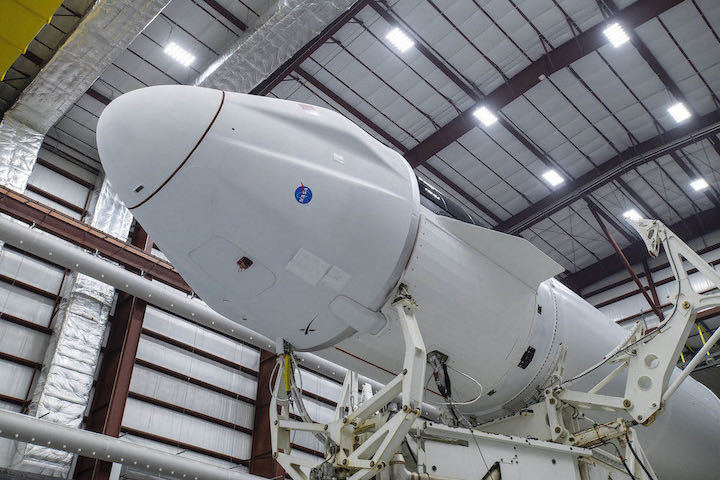
The mission also carries an experiment hosting package called the Faraday Research Facility. Developed by a Houston company named ProXops, the facility will be inserted by astronauts into one of the space station’s science racks.
On this flight, the facility carries an experiment from Houston Methodist Research Institute to test an implantable, remote-controlled drug delivery system. Scientists say the experiment could offer an alternative to bulky infusion pumps to help treat chronic conditions in patients on Earth.
NASA says facility also hosts two educational experiments to be performed on the space station, including one with participation from a Girl Scout troop on the ground.
There are also multiple CubeSats stowed inside the Cargo Dragon’s pressurized compartment. They will be robotically deployed outside the space station in the coming weeks and months.
The mission set for launch Saturday will be SpaceX’s 23rd commercial resupply flight to the space station since 2012, and the third to use a new generation of SpaceX Dragon cargo ships based on the company’s human-rated crew capsules.
NASA has multibillion-dollar contracts with SpaceX, Northrop Grumman, and Sierra Nevada Corp. to transport cargo to and from the space station.
A launch weather forecast issued Wednesday by the U.S. Space Force’s 45th Weather Squadron suggests a chance of scattered rain showers along Florida’s Space Coast early Saturday.
There is a 40% probability that weather might prevent launch Saturday morning, according to the outlook. The primary concerns are with cumulus clouds that could create a risk for lightning, and precipitation along the Falcon 9 and Cargo Dragon flight path.
There is a 30% chance of weather preventing launch during a backup launch opportunity Sunday.
Quelle: SN
+++
SpaceX Falcon 9 and Cargo Dragon vertical at KSC for CRS-23 launch

The Space Coast's first launch in nearly two months is set for early Saturday, but in typical summertime-in-Florida fashion, the weather may not cooperate.
Forecasters are anticipating just 50% "go" conditions for the 3:37 a.m. launch of a SpaceX Falcon 9 rocket and Cargo Dragon capsule from Kennedy Space Center, the opening of an instantaneous window at pad 39A. The uncrewed capsule packed with thousands of pounds of supplies and science experiments is expected to dock with the International Space Station around 11 a.m. Sunday.
Saturday's launch will mark almost exactly two months since the Space Coast last saw a rocket's smoke and fire. A combination of spacecraft readiness and resource shortages caused by the latest COVID-19 surge have contributed to the gap, which stands in stark opposition to upbeat projections from earlier in the year that called for 50-plus launches.
SpaceX president Gwynne Shotwell this week confirmed shortages of liquid oxygen – the oxidizer used alongside kerosene to make Falcon 9's propellant – were at least partially responsible for the cadence slowdown. Industrial gas and chemical suppliers have also notified other launch providers like Blue Origin that supplies might be rerouted to hospitals to help patients needing supplemental oxygen.
SpaceX's position is critical to the local launch pace, especially since the company's space-based Starlink internet comprised nearly half of 2020's 31 launches. In 2021, the ratio is even higher – Falcon 9s have flown 13 Starlink missions of the Space Coast's 21 launches overall.
Shotwell also said the worldwide chip shortage affecting cars and electronics has slowed the pace, especially since SpaceX is adding new communications hardware to its Starlink satellites. The next launch of a Starlink batch is expected in about three weeks.
Yet other issues, like spacecraft readiness in the form of Boeing's Starliner capsule, have also contributed to the drought. The vehicle was set to fly on a United Launch Alliance Atlas V rocket earlier this month, but stuck valves discovered on the pad forced Boeing to stand down, de-stack the rocket, and return Starliner to its processing facility at Kennedy Space Center. The mission involves an uncrewed test flight to the ISS followed later by astronauts hosting a crewed demonstration of the new capsule.
It remains to be seen whether Starliner can fly this year considering the other missions ULA is tasked with, like a NASA probe named Lucy that will attempt to study the Trojan asteroids of Jupiter. Liftoff on an Atlas V rocket is scheduled for no earlier than Oct. 16.
At pad 39A, the 50% "go" forecast is expected this time of year.
"A disturbance located just south of Jamaica this morning is expected to move into the Gulf over the weekend," Space Launch Delta 45 forecasters said in a pre-launch report. "While it will not directly impact east-central Florida, it will usher in mid- and upper-level moisture into our area, introducing the potential for a mid-level cloud deck."
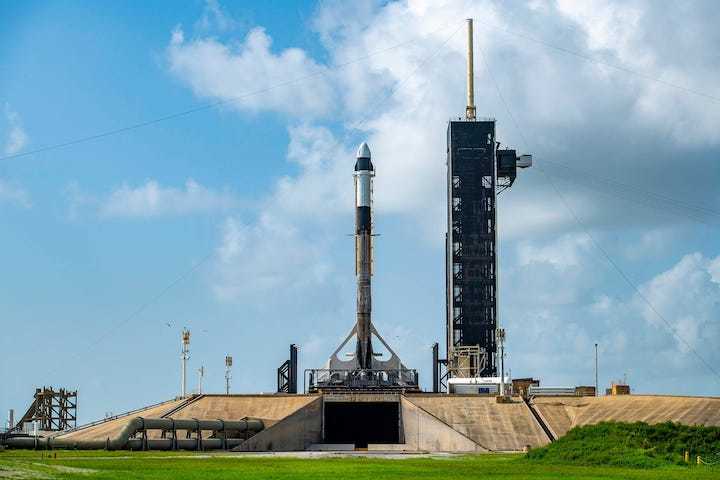
Cumulus and thick clouds, as well as the potential for flight through precipitation, were listed as the main concerns for liftoff. Upper-level winds and sea conditions in the area of a drone ship tasked with recovering the booster, however, were both listed as favorable. In the event of a delay or scrub, a second attempt on Sunday would see conditions improve slightly to 60% "go."
Because Dragon has to "catch up" with the International Space Station as it passes overhead, Falcon must fly on time — also known as an instantaneous window — or the launch has to be scrubbed. That means no waiting for inclement weather to clear.
Spectators in the area can expect temperatures just below 80 degrees as Falcon 9 launches from the pad, then slowly ascends and arc over the Atlantic Ocean on a northeast trajectory. The first stage booster will separate about two-and-a-half minutes after liftoff, after which it will descend toward the drone ship stationed a couple hundred miles downrange.
Launch Saturday, Aug. 28
- Rocket: SpaceX Falcon 9
- Mission: CRS-23 International Space Station resupply
- Launch Time: 3:37 a.m. ET
- Launch Window: Instantaneous
- Launch Pad: 39A at Kennedy Space Center
- Trajectory: Northeast
- Landing: Drone ship
- Weather: 50% "go"
Quelle: Florida Today
----
Update: 28.08.2021 / 9.35 MESZ
.
Standing down from today’s launch due to weather; next launch opportunity is Sunday, August 29 at 3:14 a.m. ET








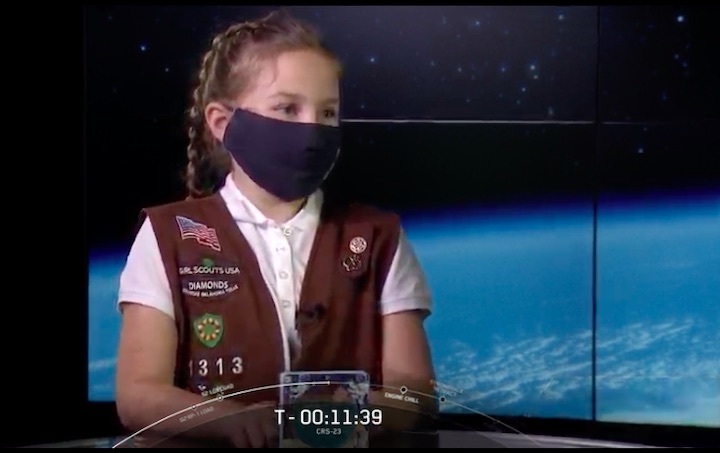



+++
Update: 29.08.2021
.
Start von SpaceX Falcon 9 mit CRS-23 Mission





















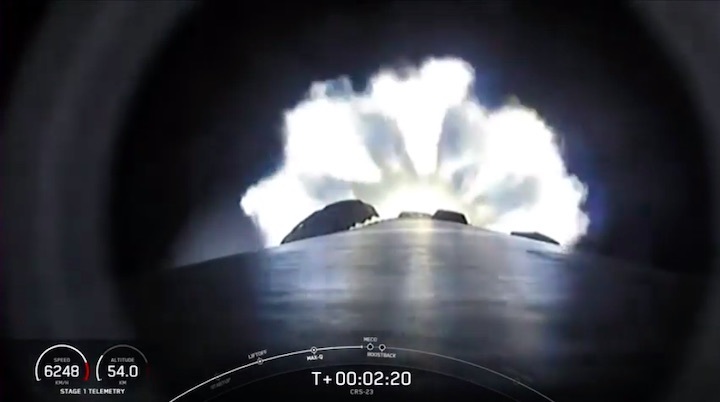
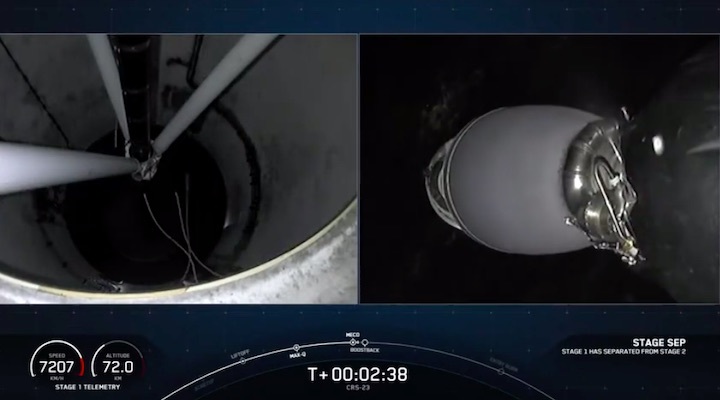





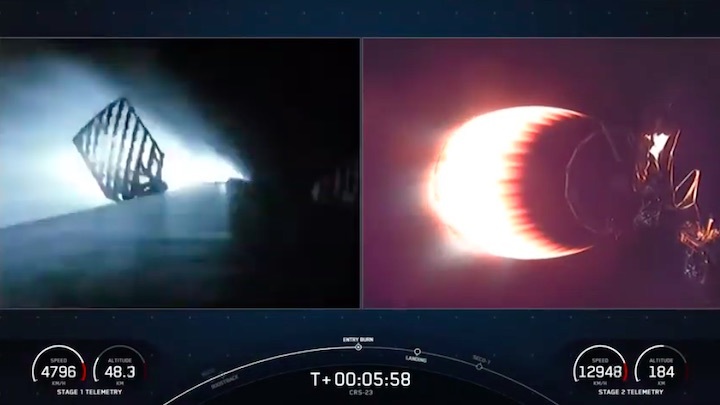






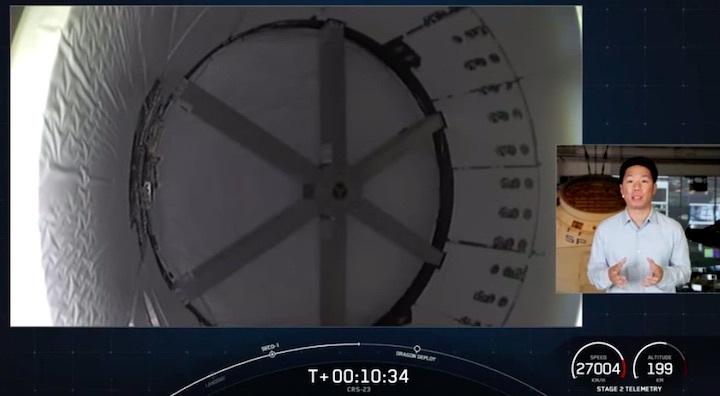
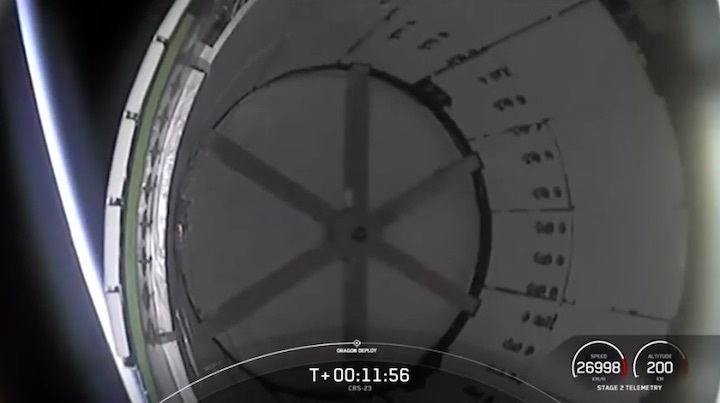
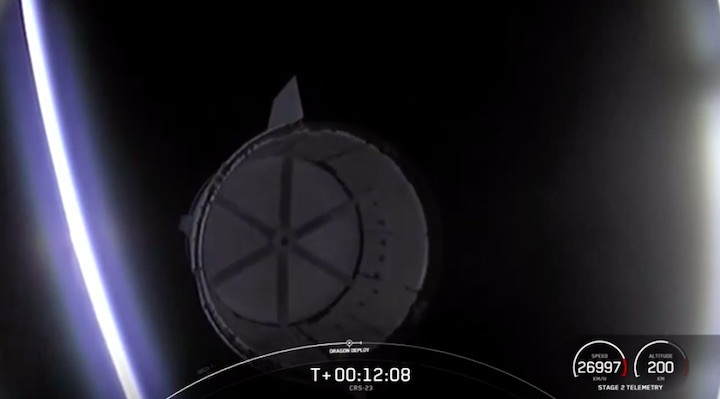


Quelle: SpaceX
